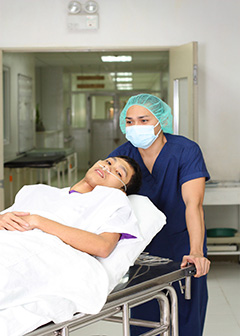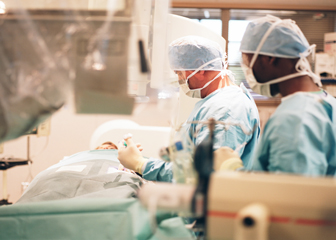Surgical Assistant or Technologist
Surgical Assistant or Technologist
Does this career fit your work personality?
Begin The Career Assessment Test- Best Fitting Careers
- Work Personality Strengths
- Work Style Preferences
- and more
Job Outlook
Overall employment of surgical assistants and technologists is projected to grow 5 percent from 2022 to 2032, faster than the average for all occupations.
About 8,600 openings for surgical assistants and technologists are projected each year, on average, over the decade. Many of those openings are expected to result from the need to replace workers who transfer to different occupations or exit the labor force, such as to retire.
What Surgical Assistants and Technologists Do
Surgical assistants and technologists help with surgical operations. Surgical assistants, also called surgical first assistants, help surgeons with tasks such as making incisions, placing clamps, and closing surgical sites. Surgical technologists, also called operating room technicians, prepare operating rooms, arrange equipment, and help doctors and first assistants during surgeries.
Duties
Surgical technologists typically do the following:
- Prepare operating rooms for surgery
- Sterilize equipment and make sure that there are adequate supplies for surgery
- Ready patients for surgery, such as by washing and disinfecting incision sites
- Help surgeons during surgery by passing them instruments and other sterile supplies
- Count supplies, such as surgical instruments, to ensure that no foreign objects are retained in patients
- Maintain a sterile environment to prevent patient infection
Before an operation, surgical technologists prepare the operating room by setting up surgical instruments and equipment. They prepare sterile solutions and medications used in surgery and check that all surgical equipment is working properly. Surgical technologists also bring patients to the operating room and get them ready for surgery by positioning them on the table, covering them with sterile drapes, and washing and disinfecting incision sites. And they help the surgical team put on sterile gowns.
During an operation, surgical technologists pass the sterile instruments and supplies to surgeons and first assistants. They might hold retractors, hold internal organs in place during the procedure, or set up robotic surgical equipment. Technologists also may handle specimens taken for laboratory analysis.
After the operation is complete, surgical technologists may apply bandages and other dressings to the incision site. They may also transfer patients to recovery rooms and restock operating rooms after a procedure.
Surgical assistants have a hands-on role, directly assisting surgeons during a procedure. For example, they may help to suction the incision site or suture a wound.
Surgical assistants and technologists work as members of a healthcare team alongside physicians and surgeons, registered nurses, and other healthcare workers.

Work Environment

Surgical assistants held about 19,700 jobs in 2022. The largest employers of surgical assistants were as follows:
| General medical and surgical hospitals; state, local, and private | 43% |
| Offices of dentists | 24 |
| Offices of physicians | 19 |
| Outpatient care centers | 5 |
Surgical technologists held about 109,200 jobs in 2022. The largest employers of surgical technologists were as follows:
| Hospitals; state, local, and private | 71% |
| Outpatient care centers | 12 |
| Offices of physicians | 12 |
| Administrative and support services | 2 |
| Offices of dentists | 1 |
Ambulatory surgical centers are included in outpatient care centers.
Surgical assistants and technologists wear scrubs and sterile gowns, gloves, caps, and masks while they are in the operating room. Their work may be physically demanding, requiring them to be on their feet for long periods. Surgical technologists also may need to help move patients or lift heavy trays of medical supplies. At times, they may be exposed to communicable diseases and unpleasant sights, odors, and materials.
Work Schedules
Most surgical assistants and technologists work full time. Surgical assistants and technologists employed in hospitals may work or be on call during nights, weekends, and holidays. They may also be required to work shifts lasting longer than 8 hours.
Getting Started
How to Become a Surgical Assistant or Technologist

Surgical assistants and technologists typically need a certificate or an associate’s degree. Employers may require or prefer that workers have certification. Some states regulate these workers.
Education
Surgical assistants and technologists typically need a certificate or associate’s degree from an accredited program. Many community colleges and vocational schools, as well as some universities and hospitals, offer accredited surgical technology or surgical assisting programs.
Surgical assistants may complete a formal education program in surgical assisting. Others may work as surgical technologists and receive additional on-the-job training to become first assistants.
Surgical technology education includes courses such as anatomy, microbiology, and physiology. These workers also learn about the care and safety of patients, sterilization techniques, how to set up technical or robotic equipment, and preventing and controlling infections. In addition to classroom study, students gain hands-on experience in supervised clinical settings.
The Commission on Accreditation of Allied Health Education Programs (CAAHEP) accredits programs in surgical technology and surgical assisting.
Licenses, Certifications, and Registrations
Certification may be beneficial for finding a job, and some employers may require it. Surgical assistants and technologists may earn certification through credentialing organizations.
For example, certification through the National Board of Surgical Technology and Surgical Assisting allows the use of the title “Certified Surgical Technologist (CST).” Certification typically requires completing an accredited formal education program or military training program and passing an exam.
Certification through the National Center for Competency Testing allows the use of the title “Tech in Surgery – Certified or TS-C (NCCT).” Applicants may qualify through formal education, military training, or work experience. All require documenting critical skills and passing an exam.
The National Board of Surgical Technology and Surgical Assisting, the National Commission for the Certification of Surgical Assistants, and the American Board of Surgical Assistants offer certification for surgical assistants.
In addition, many jobs require that surgical assistants and technologists become certified in CPR or basic life support (BLS), or both.
Some states have regulations governing the work of surgical assistants and technologists. For more information, contact your state licensing agency.
Advancement
Surgical assistants and technologists may choose to advance to other healthcare occupations, such as registered nurse. Advancement to other healthcare occupations usually requires additional education, training, and/or certifications or licenses. A technologist may also choose to become a postsecondary teacher of health specialties.
Contacts for More Information
For more information about surgical technologists, visit
Association of Surgical Technologists
For a list of accredited programs for surgical assistants and technologists, visit
Commission on Accreditation of Allied Health Education Programs
For information about certification, visit
The National Board of Surgical Technology and Surgical Assisting
National Center for Competency Testing
National Commission for the Certification of Surgical Assistants
Similar Occupations
This table shows a list of occupations with job duties that are similar to those of surgical assistants and technologists.
| Occupation | Job Duties | Entry-Level Education | Median Annual Pay, May 2022 | |
|---|---|---|---|---|

|
Dental Assistants |
Dental assistants provide patient care, take x rays, keep records, and schedule appointments. |
Postsecondary nondegree award | $44,820 |

|
Licensed Practical and Licensed Vocational Nurses |
Licensed practical nurses (LPNs) and licensed vocational nurses (LVNs) provide basic medical care. |
Postsecondary nondegree award | $54,620 |

|
Clinical Laboratory Technologists and Technicians |
Clinical laboratory technologists and technicians perform medical laboratory tests for the diagnosis, treatment, and prevention of disease. |
Bachelor's degree | $57,380 |

|
Medical Assistants |
Medical assistants complete administrative and clinical tasks, such as scheduling appointments and taking patients’ vital signs. |
Postsecondary nondegree award | $38,270 |

|
Physicians and Surgeons |
Physicians and surgeons diagnose and treat injuries or illnesses and address health maintenance. |
Doctoral or professional degree | $229,300 |

|
Registered Nurses |
Registered nurses (RNs) provide and coordinate patient care and educate patients and the public about various health conditions. |
Bachelor's degree | $81,220 |
